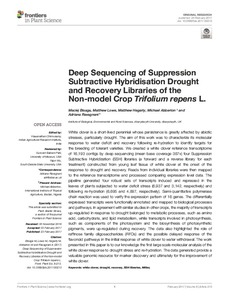| dc.contributor.author | Bisaga, M. |
| dc.contributor.author | Lowe, M. |
| dc.contributor.author | Hegarty, M. |
| dc.contributor.author | Abberton, M.T. |
| dc.contributor.author | Ravagnani, A. |
| dc.date.accessioned | 2019-12-04T11:10:15Z |
| dc.date.available | 2019-12-04T11:10:15Z |
| dc.date.issued | 2017 |
| dc.identifier.citation | Bisaga, M., Lowe, M., Hegarty, M., Abberton, M. & Ravagnani, A. (2017). Deep sequencing of Suppression Subtractive Hybridisation drought and recovery libraries of the non-model crop Trifolium repens L. Frontiers in Plant Science, 8(213), 1-38. |
| dc.identifier.issn | 1664-462X |
| dc.identifier.uri | https://hdl.handle.net/20.500.12478/2047 |
| dc.description | Open Access Journal; Published online: 23 Feb. 2017 |
| dc.description.abstract | White clover is a short-lived perennial whose persistence is greatly affected by abiotic stresses, particularly drought. The aim of this work was to characterize its molecular response to water deficit and recovery following re-hydration to identify targets for the breeding of tolerant varieties. We created a white clover reference transcriptome of 16,193 contigs by deep sequencing (mean base coverage 387x) four Suppression Subtractive Hybridization (SSH) libraries (a forward and a reverse library for each treatment) constructed from young leaf tissue of white clover at the onset of the response to drought and recovery. Reads from individual libraries were then mapped to the reference transcriptome and processed comparing expression level data. The pipeline generated four robust sets of transcripts induced and repressed in the leaves of plants subjected to water deficit stress (6,937 and 3,142, respectively) and following re-hydration (6,695 and 4,897, respectively). Semi-quantitative polymerase chain reaction was used to verify the expression pattern of 16 genes. The differentially expressed transcripts were functionally annotated and mapped to biological processes and pathways. In agreement with similar studies in other crops, the majority of transcripts up-regulated in response to drought belonged to metabolic processes, such as amino acid, carbohydrate, and lipid metabolism, while transcripts involved in photosynthesis, such as components of the photosystem and the biosynthesis of photosynthetic pigments, were up-regulated during recovery. The data also highlighted the role of raffinose family oligosaccharides (RFOs) and the possible delayed response of the flavonoid pathways in the initial response of white clover to water withdrawal. The work presented in this paper is to our knowledge the first large scale molecular analysis of the white clover response to drought stress and re-hydration. The data generated provide a valuable genomic resource for marker discovery and ultimately for the improvement of white clover. |
| dc.description.sponsorship | Biotechnology and Biological Sciences Research Council, United Kingdom |
| dc.format.extent | 1-39 |
| dc.language.iso | en |
| dc.subject | White Clover |
| dc.subject | Drought |
| dc.subject | Recovery |
| dc.subject | Ssh Libraries |
| dc.subject | Miseq |
| dc.subject | Genometic |
| dc.subject | Rna Extraction |
| dc.subject | Cdna Synthesis |
| dc.subject | Sqrt-Pcr |
| dc.subject | Hybridization |
| dc.title | Deep sequencing of Suppression Subtractive Hybridisation drought and recovery libraries of the non-model crop Trifolium repens L. |
| dc.type | Journal Article |
| dc.description.version | Peer Review |
| cg.contributor.crp | Roots, Tubers and Bananas |
| cg.contributor.affiliation | Aberystwyth University |
| cg.contributor.affiliation | International Institute of Tropical Agriculture |
| cg.researchtheme | BIOTECH & PLANT BREEDING |
| cg.isijournal | ISI Journal |
| cg.authorship.types | CGIAR and advanced research institute |
| cg.iitasubject | Plant Breeding |
| cg.iitasubject | Plant Genetic Resources |
| cg.journal | Frontiers in Plant Science |
| cg.howpublished | Formally Published |
| cg.accessibilitystatus | Open Access |
| local.dspaceid | 86043 |
| cg.targetaudience | Scientists |
| cg.identifier.doi | https://dx.doi.org/10.3389/fpls.2017.00213 |

